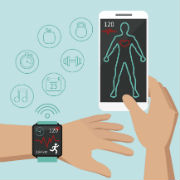Growth of Medical IoT Devices Supports Healthcare Analytics
The continued growth of wearable IoT devices in healthcare shows a promising future for predictive analytics and population health.

- Medical wearable devices are carving out their place in healthcare as several reports recognize the continued growth of the internet of things in healthcare.

Research and Markets anticipates high growth for the wearable medical device market through 2022. The report cites versatility, portability, and usability as appealing factors driving patient adoption.
“These devices are wearable health tools, which aid in clinical monitoring of the body vitals outside hospitals,” the research group stated. “These wearable medical devices find application in monitoring of heart rate, blood glucose, and blood oxygen levels amongst others. Moreover, these devices can also be used for tracking physical activity, fitness and sleeping patterns of an individual.”
Wearable medical devices also assist organizations looking to cut down on in-person visits for patients with minor health issues or follow up appointments. Physicians are also showing interest in remotely monitoring patients to improve quality of care using wearable medical devices, the report found.
Another report by Mind Commerce outlines similar findings concerning the healthcare IoT, owing the industry growth to various high tech innovations surrounding connected health dependent on emerging IoT technologies, services, and solutions.
Mind Commerce analysts focused on the need for real-time health data as big data analytics tools are used to evaluate the data collected from wearable medical devices for predictive analytics and population health incentives.
Healthcare has suffered from a lack of large-scale data interoperability with organizations only recently given capabilities to truly make something of the massive amounts of unstructured data being collected.
Electronic health records (EHRs) are a great source of health data for analysts, but are limiting in the amount of stuctured data they present. Recorded vitals and lists of symptoms are helpful, but can only offer so much insight into population health. The technology to discover deeper and more valuable connections exists with analytic solutions and the IoT, but an organization’s health IT infrastructure needs to be able to support the volume of data wearable and other connected medical devices collect.
“Clinical data is where the most successful hospitals start their analytics problems, but to deliver a higher level of consumer satisfaction, providers must know a lot more about their patients and their needs than the EHR can tell,” says HealthITAnalytics.com.
“The IoT can provide that data, if healthcare organizations build the infrastructure to accept it,” HealthITAnalytics.com continued. “Many providers have been able to integrate financial and utilization data to create a portrait of organizational operations, but these sources do not give a clear idea of what patients do on their own time.”
Wearable medical devices are the answer to collecting the data needed to draw better and more accurate conclusions based on a patient’s personal lifestyle and habits. Patients can even use their own personal wearables such as smartwatches and fitness bands to help healthcare organizations collect this data.
Organizations have been hesitant to fully embrace IoT data because the amount of data produced can be overwhelming. Clinicians become understandably frustrated when the overwhelming amount of data becomes too much to sift through leaving them no closer to treating their patients more effectively.
Organizations lacking a big data analytics solution will find it impossible to use IoT data with any kind of significant impact because of its unstructured form and sheer volume. Artificial intelligence and cognitive computing technologies used in big data analytics take large volumes of unstructured data and make human-like connections to draw conclusions clinicians would not be able to make without wearable device insight.
However, the IoT data collected needs to be integrated into the patient’s record in a format compatible with the organization's EHR technology so an end-user can easily view and document the information received. Analytic solutions such as Hadoop may be able to handle this type of data.
Although analytic solutions are not the easiest part of a health IT infrastructure to deploy, the growth of medical IoT devices is a promising sign for the future of population health, predictive analytics, and the quality patient care.
Dig Deeper:
- IBM Watson Expands Consulting Support to Internet of Things
- How Hadoop Supports Healthcare Data Analytics Infrastructure
